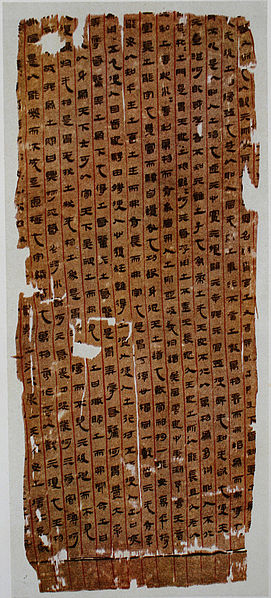Tao Te Ching
The Tao Te Ching is a Chinese classic text and foundational work of Taoism traditionally credited to the sage Laozi, though the text's authorship, date of composition and date of compilation are debated. The oldest excavated portion dates to the late 4th century BC.
Title
In English, the title is commonly rendered Tao Te Ching, which can be translated many different ways:
- The Classic of the Way and its Power
- The Book of the Tao and Its Virtue
- The Book of the Way and of Virtue
- The Tao and its Characteristics
- The Canon of Reason and Virtue
- The Classic Book of Integrity and the Way
- A Treatise on the Principle and Its Action
Ancient Chinese books were commonly referenced by the name of their real or supposed author, in this case the Old Master Laozi. As such, the Tao Te Ching is also sometimes referred to as the Laozi, especially in Chinese sources.
Original manuscripts
Beginning in the 1920s and 1930s, Marc Aurel Stein and others found thousands of scrolls in the Mogao Caves near Dunhuang. They included more than 50 partial and complete manuscripts. Another partial manuscript has the Xiang'er commentary, which had previously been lost.
In 1973, archaeologists discovered copies of early Chinese books, known as the Mawangdui Silk Texts, in a tomb dated to 168 BC. They included two nearly complete copies of the text, referred to as Text A and Text B. Both of which reverse the traditional ordering and put the Te Ching section before the Tao Ching. Based on calligraphic styles and imperial naming taboo avoidances, scholars believe that Text A can be dated to about the first decade and Text B to about the third decade of the 2nd century BC.
In 1993, the oldest known version of the text, written on bamboo slips, was found in a tomb near the town of Guodian in Jingmen, Hubei, and dated prior to 300 BC. The Guodian Chu Slips comprise around 800 slips of bamboo with a total of over 13,000 characters, about 2,000 of which correspond with the Tao Te Ching.
Both the Mawangdui and Guodian versions are generally consistent with the later texts handed down to the modern era, with only minor differences in chapter sequence and graphic variants. Several recent Tao Te Ching translations utilise these two versions, sometimes with the verses reordered to synthesize the new finds.
Authorship
The Tao Te Ching was traditionally ascribed to Laozi, whose historical existence has been a matter of scholarly debate. His name, which means "Old Master," has only fuelled controversy on this issue. Legends claim variously that Laozi was "born old" and that he lived for 996 years, with twelve previous incarnations starting around the time of the Three Sovereigns before the thirteenth as Laozi. Some scholars have expressed doubts over Laozi's historicity.
The first biographical reference to Laozi is in the Records of the Grand Historian, by Chinese historian Sima Qian (c. 145–86 BC), which combines three stories.
Content
The Tao Te Ching describes the Tao as the source and ideal of all existence: it is unseen, but not transcendent, immensely powerful yet supremely humble, being the root of all things.
People have desires and free will (and thus are able to alter their own nature). Many act "unnaturally", upsetting the natural balance of the Tao. The Tao Te Ching intends to lead students to a "return" to their natural state, in harmony with Tao. Language and conventional wisdom are critically assessed. Taoism views them as inherently biased and artificial, widely using paradoxes to sharpen the point.
Wu wei, literally 'non-action' or 'not acting', is a central concept of the Tao Te Ching. The concept of wu wei is multifaceted, and reflected in the words' multiple meanings, even in English translation; it can mean "not doing anything," "not forcing," "not acting" in the theatrical sense, "creating nothingness," "acting spontaneously," and "flowing with the moment."
This concept is used to explain ziran, or harmony with the Tao. It includes the concepts that value distinctions are ideological and seeing ambition of all sorts as originating from the same source. Tao Te Ching used the term broadly with simplicity and humility as key virtues, often in contrast to selfish action. On a political level, it means avoiding such circumstances as war, harsh laws and heavy taxes. Some Taoists see a connection between wu wei and esoteric practices, such as zuowang ('sitting in oblivion': emptying the mind of bodily awareness and thought) found in the Zhuangzi.
Translations
The Tao Te Ching has been translated into Western languages over 250 times, mostly to English, German, and French. At one time, the text was like a famous puzzle which everyone would like to feel he had solved.
The first English translation was produced in 1868 by the Scottish Protestant missionary John Chalmers, entitled The Speculations on Metaphysics, Polity, and Morality of the Old Philosopher Lau-tsze. Other notable English translations are those produced by Chinese scholars and teachers:
- a 1948 translation by linguist Lin Yutang
- a 1961 translation by author John Ching Hsiung Wu
- a 1963 translation by sinologist Din Cheuk Lau
- another 1963 translation by professor Wing-tsit Chan
- a 1972 translation by Taoist teacher Gia-Fu Feng together with his wife Jane English
Aleister Crowley
During his time wandering through China from 1905 - 1906, British occultist Aleister Crowley discovered the Tao Te Ching. He describes this moment as an intensely spiritual experience:
"During my solitary wanderings among the mountainous wastes of Yun Nan, the spiritual atmosphere of China penetrated my consciousness, thanks to the absence of any intellectual impertinences from the organ of knowledge. The TAO TEH KING revealed its simplicity and sublimity to my soul, little by little, as the conditions of my physical life, no less than of my spiritual, penetrated the sanctuaries of my spirit."
In 1918, Crowley visited Esopus Island in the New York's Hudson River. While on the island, he undertook a translation of the Tao Te Ching, but quickly realized he was not capable of rendering the Chinese text into English given his lack of proficiency with the Chinese language. After consulting a spiritual guide named Amalantrah, Crowley was inspired to compare the original Chinese text with James Legg's 1891 English translation then simply paraphrase the English with his enlightened revelations concerning spirituality. His resulting "translation" was completed in three days, and subsequently revised over the next few years.
Crowley's version of the text was published in 1923 as the Tao Teh King (Liber CLVII) under the assumed name "Ko Yuen." In the introduction, Crowley explains his methods and admits: "It is therefore not altogether without confidence that I present this translation of the Tao Teh King to the public."

